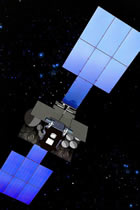Boeing recently demonstrated communication capabilities between its Transformational Satellite Communications (TSAT) laser communications terminal and BAE Systems’ Airborne Lasercom Risk Reduction Terminal (ALT) demonstrating interoperability between terminals built by Boeing, Ball Aerospace and BAE Systems. The demonstration used several optical waveforms to route TSAT communication signals through the Lasercom Terminal at data rates of up to 10 gigabytes per second. The test demonstrated the TSAT capability to switch laser communications links between TSAT and ATL satellites.
The lab test comprised a telescope, optical bench assembly, and closed-loop pointing and tracking hardware.
TSAT is scheduled to begin U.S. military service by 2014. It is designed to provide conventional communications services and laser communication capabilities to all branches of the military, including space and airborne platforms. The data capacity afforded by the Lasercom service will start at 2.5 gigabytes per second, nearly the equivalent of 150 simultaneous high definition television channels. TSAT will open up new airborne mission possibilities in the areas of command and control, surveillance and reconnaissance.
The Boeing team, which includes Raytheon, Ball Aerospace, General Dynamics, IBM, L-3 Communications, Cisco Systems, BBN Technologies, Hughes Network Systems, Lucent Technologies, Harris, EMS Technologies, ICE and Alpha Informatics, is working under a $514 million U.S. Air Force contract for the TSAT Space Segment Risk Reduction and System Definition program.
















